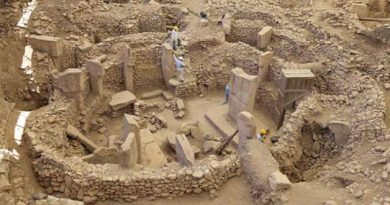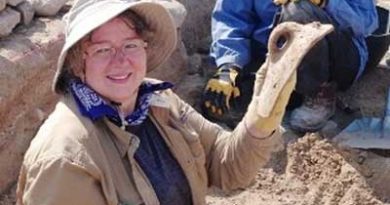Nazareth, Jesus’ village
Nazareth (/ˈnæzərəθ/; Hebrew: נָצְרַת, Natzrat; Arabic: النَّاصِرَة, an-Nāṣira; Aramaic: ܢܨܪܬ, Naṣrath) is the capital and the largest city in the Northern District of Israel. Nazareth is known as “the Arab capital of Israel”.[2] In 2017 its population was 76,551.[1] The inhabitants are predominantly Arab citizens of Israel, of whom 69% are Muslim and 30.9% Christian.[2][3][4][5] Nazareth Illit (lit. “Upper Nazareth”), declared a separate city in June 1974, is built alongside old Nazareth, and had a Jewish population of 40,312 in 2014.[6]
In the New Testament, the town is described as the childhood home of Jesus,[7] and as such is a center of Christian pilgrimage, with many shrines commemorating biblical events.
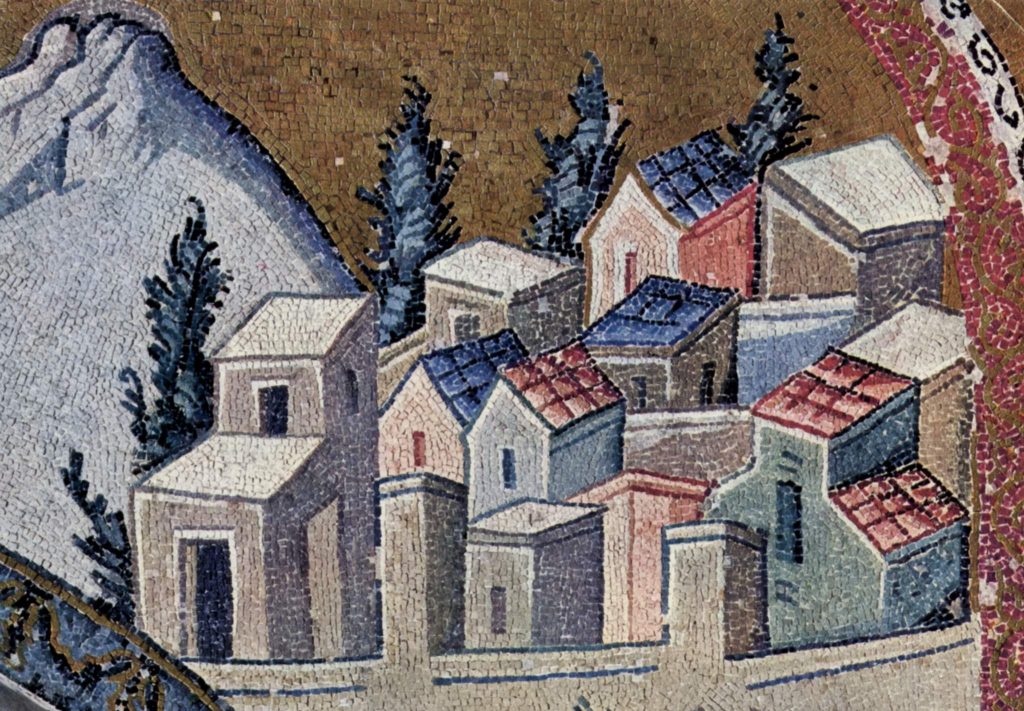
Etymology
Hebrew Netzer
One view holds that “Nazareth” is derived from one of the Hebrew words for ‘branch’, namely ne·ṣer, נֵ֫צֶר,[8] and alludes to the prophetic, messianic words in Book of Isaiah 11:1, ‘from (Jesse’s) roots a Branch (netzer) will bear fruit’. One view suggests this toponym might be an example of a tribal name used by resettling groups on their return from exile.[9] Alternatively, the name may derive from the verb na·ṣar, נָצַר, “watch, guard, keep,”[10] and understood either in the sense of “watchtower” or “guard place”, implying the early town was perched on or near the brow of the hill, or, in the passive sense as ‘preserved, protected’ in reference to its secluded position.[11] The negative references to Nazareth in the Gospel of John suggest that ancient Jews did not connect the town’s name to prophecy.[12]
Another theory holds that the Greek form Nazara, used in Matthew and Luke, may derive from an earlier Aramaic form of the name, or from another Semitic language form.[13] If there were a tsade (צ) in the original Semitic form, as in the later Hebrew forms, it would normally have been transcribed in Greek with a sigma instead of a zeta.[14] This has led some scholars to question whether “Nazareth” and its cognates in the New Testament actually refer to the settlement known traditionally as Nazareth in Lower Galilee.[15] Such linguistic discrepancies may be explained, however, by “a peculiarity of the ‘Palestinian’ Aramaic dialect wherein a sade (ṣ) between two voiced (sonant) consonants tended to be partially assimilated by taking on a zayin (z) sound.”[14]
Arabic an-Nāṣira
The Arabic name for Nazareth is an-Nāṣira, and Jesus (Arabic: يَسُوع, Yasū`) is also called an-Nāṣirī, reflecting the Arab tradition of according people an attribution, a name denoting whence a person comes in either geographical or tribal terms. In the Qur’an, Christians are referred to as naṣārā, meaning “followers of an-Nāṣirī”, or “those who follow Jesus of Nazareth”.[16]
New Testament references
In Luke’s Gospel, Nazareth is first described as ‘a town of Galilee’ and home of Mary (Luke 1:26). Following the birth and early epiphanial events of chapter 2 of Luke’s Gospel, Mary, Joseph and Jesus “returned to Galilee, to their own city, Nazareth”.[17]
In English translations of the New Testament, the phrase “Jesus of Nazareth” appears seventeen times whereas the Greek has the form “Jesus the Nazarēnos” or “Jesus the Nazōraios.”[18] One plausible view is that Nazōraean (Ναζωραῖος) is a normal Greek adaptation of a reconstructed, hypothetical term in Jewish Aramaic for the word later used in Rabbinical sources to refer to Jesus.[19] “Nazaréth” is named twelve times in surviving Greek manuscript versions of the New Testament, 10 times as Nazaréth or Nazarét,[20] and twice as Nazará.[14] The former two may retain the ‘feminine’ endings common in Galilean toponyms.[14] The minor variants, Nazarat and Nazarath are also attested.[21] Nazara (Ναζαρά) might be the earliest form of the name in Greek, going back to the putative Q document. It is found in Matthew 4:13 and Luke 4:16.[14][dubious – discuss] However, the Textus Receptus clearly translates all passages as Nazara leaving little room for debate there.[22]
Many scholars have questioned a link between “Nazareth” and the terms “Nazarene” and “Nazoraean” on linguistic grounds,[23] while some affirm the possibility of etymological relation “given the idiosyncrasies of Galilean Aramaic.”[24]
Extrabiblical references
The form Nazara is also found in the earliest non-scriptural reference to the town, a citation by Sextus Julius Africanus dated about 221 AD[25] (see “Middle Roman to Byzantine Periods” below). The Church Father Origen (c. 185 to 254 AD) knows the forms Nazará and Nazarét.[26] Later, Eusebius in his Onomasticon (translated by St. Jerome) also refers to the settlement as Nazara.[27] The nașirutha of the scriptures of the Mandeans refers to “priestly craft”, not to Nazareth, which they identified with Qom.[28]
The first non-Christian reference to Nazareth is an inscription on a marble fragment from a synagogue found in Caesarea Maritima in 1962.[29] This fragment gives the town’s name in Hebrew as נצרת (n-ṣ-r-t). The inscription dates to c. AD 300 and chronicles the assignment of priests that took place at some time after the Bar Kokhba revolt, AD 132-35.[30] (See “Middle Roman to Byzantine Periods” below.) An 8th-century AD Hebrew inscription, which was the earliest known Hebrew reference to Nazareth prior to the discovery of the inscription above, uses the same form.[14]
Nazarenes, Nasranis, Notzrim, Christians
Main article: Nazarene (title)
Around 331, Eusebius records that from the name Nazareth Christ was called a Nazoraean, and that in earlier centuries Christians, were once called Nazarenes.[31] Tertullian (Against Marcion 4:8) records that “for this reason the Jews call us ‘Nazarenes’.” In the New Testament Christians are called “Christians” three times by Paul in Romans, and “Nazarenes” once by Tertullus, a Jewish lawyer. The Rabbinic and modern Hebrew name for Christians, notzrim, is also thought to derive from Nazareth, and be connected with Tertullus’ charge against Paul of being a member of the sect of the Nazarenes, Nazoraioi, “men of Nazareth” in Acts. Against this some medieval Jewish polemical texts connect notzrim with the netsarim “watchmen” of Ephraim in Jeremiah 31:6. In Syriac Aramaic Nasrath (ܢܨܪܬ) is used for Nazareth, while “Nazarenes” (Acts 24:5) and “of Nazareth” are both Nasrani or Nasraya (ܕܢܨܪܝܐ) an adjectival form.[32][33][34] Nasrani is used in the Quran for Christians, and in Modern Standard Arabic may refer more widely to Western people.[35] Saint Thomas Christians, an ancient community of Jewish Christians in India who trace their origins to evangelistic activity of Thomas the Apostle in the 1st century, are sometimes known by the name “Nasrani” even today.[36][37]
Religious sites
Christian
Churches
- The Church of the Annunciation is the largest Catholic church in the Middle East. In Roman Catholic tradition, it marks the site where the Archangel Gabriel announced the future birth of Jesus to Mary (Luke 1:26–31)
- The Church of St. Gabriel is an alternative Greek Orthodox site for the Annunciation
- The Synagogue Church is a Melkite Greek Catholic Church at the traditional site of the synagogue where Jesus preached (Luke 4)
- The St. Joseph’s Church (Roman Catholic) marks the traditional location for the workshop of Saint Joseph
- The Mensa Christi Church, run by the Franciscan religious order, commemorates the traditional location where Jesus dined with the Apostles
- The Basilica of Jesus the Adolescent, run by the Salesian religious order, at the top of the hill overlooking the city from the north
- The Church of Christ is an Anglican church in Nazareth
- The Church of Our Lady of the Fright (Roman Catholic) marks the spot where Mary is said to have seen Jesus being taken to a cliff by the congregation of the synagogue
“Jesus Trail”
- The Jesus Trail pilgrimage route connects many of the religious sites in Nazareth on a 60 km (37 mi) walking trail which ends in Capernaum
Other
- International Marian Evangelization Center “Mary of Nazareth” (see here: [120]), containing among other things the only archaeologically excavated house from first-century CE Nazareth
Muslim
Muslim holy sites include
- The Shrine of al-Sheikh Amer
- The Shrine of “to the Prophet we go” (Makam Ela-Nabi Sa’in Mosque)
- The Shrine of Shihab ad-Din.
Muslim places of worship include
- The White Mosque (Masjid al-Abiad), the oldest mosque in Nazareth, located in Harat Alghama (“Mosque Quarter”) in the center of the Old Market.
- The Peace Mosque (Masjid al-Salam).
Archaeology
“Venerated area” near the Basilica of the Annunciation
While excavations conducted prior to 1931 in the Franciscan “venerated area” (the side of the hill known as Jabal Nebi Sa’in, stretching north of the Basilica of the Annunciation) revealed no trace of a Greek or Roman settlement there, later digs under Fr. Bagatti, who acted as the principal archaeologist for the venerated sites in Nazareth, unearthed quantities of later Roman and Byzantine artifacts, attesting to unambiguous human presence there from the 2nd century AD onward. John Dominic Crossan, a noted New Testament scholar, remarked that Bagatti’s archaeological drawings indicate just how small the village actually was, suggesting that it was little more than an insignificant hamlet.
Early Roman house
Remains of a residential house dating to the Early Roman period were discovered in 2009 next to the Basilica of the Annunciation and are on display in the “International Marian Center of Nazareth”. According to the Israel Antiquities Authority, “The artifacts recovered from inside the building were few and mostly included fragments of pottery vessels from the Early Roman period (the first and second centuries AD)… Another hewn pit, whose entrance was apparently camouflaged, was excavated and a few pottery sherds from the Early Roman period were found inside it.” Archaeologist Yardenna Alexandre adds that “based on other excavations that I conducted in other villages in the region, this pit was probably hewn as part of the preparations by the Jews to protect themselves during the Great Revolt against the Romans in 67 AD”.
Kokh tombs
Noteworthy is that all the post-Iron Age tombs in the Nazareth basin (approximately two dozen) are of the kokh (plural kokhim) or later types; this type probably first appeared in Galilee in the middle of the 1st century AD. Kokh tombs in the Nazareth area have been excavated by B. Bagatti, N. Feig, Z. Yavor, and noted by Z. Gal.
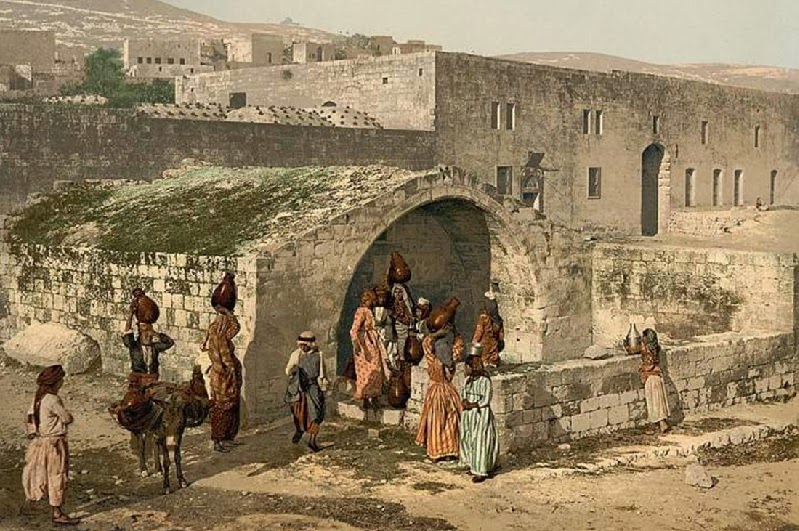
Ancient bathhouse at Mary’s Well
In the mid-1990s, a shopkeeper discovered tunnels under his shop near Mary’s Well in Nazareth. The tunnels were identified as the hypocaust of a bathhouse. Excavations in 1997–98 revealed remains dating from the Roman, Crusader, Mamluk and Ottoman periods.
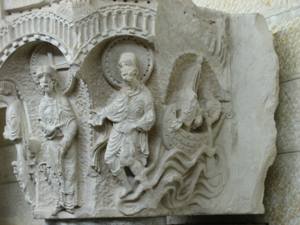
References
- “List of localities, in Alphabetical order” (PDF). Israel Central Bureau of Statistics. Retrieved August 26, 2018.
- Laurie King-Irani (Spring 1996). “Review of “Beyond the Basilica: Christians and Muslims in Nazareth””. Journal of Palestine Studies. 25 (3): 103–105. doi:10.1525/jps.1996.25.3.00p0131i. JSTOR 2538265.
- “2005” (PDF). Cbs.gov.il. Retrieved 2012-11-16.
- Dumper, Michael; Stanley, Bruce E.; Abu-Lughod, Janet L. (2006). Cities of the Middle East and North Africa: a historical encyclopedia (Illustrated ed.). ABC-CLIO. pp. 273–274. ISBN 9781576079195.
- Kanaaneh, Rhoda Ann (2002), Birthing the nation: strategies of Palestinian women in Israel, University of California Press, p. 117, ISBN 978-0-520-22379-0, All-Arab cities such as Nazareth, the largest Palestinian city in IsraelQuigley, John (1997), Flight into the maelstrom: Soviet immigration to Israel and Middle East peace, Garnet & Ithaca Press, p. 190, ISBN 978-0-86372-219-6, The other major Jewish population centre in Galilee was Upper Nazareth, established next to Nazareth, the principal Palestinian city in Arab-populated Galilee.
- “Table 3 – Population of Localities Numbering Above 2,000 Residents and Other Rural Population” (PDF). Israel Central Bureau of Statistics. 2010-06-30. Retrieved 2010-10-31.
- Jeffrey, David L. (1992). A Dictionary of biblical tradition in English literature. Wm. B. Eerdmans Publishing. pp. 538–40. ISBN 978-0-85244-224-1.
- The other is zemach.
- Bargil Pixner, cited in Paul Barnett,Jesus & the Rise of Early Christianity: A History of New Testament Times,InterVarsity Press, 2002 p. 89, n. 80.
- “…if the word Nazareth is be derived from Hebrew at all, it must come from this root [i.e. נָצַר, naṣar, to watch]” (Merrill, Selah, (1881) Galilee in the Time of Christ, p. 116.
- Francis Brown, S. R. Driver, Charles A. Briggs, The Brown-Driver-Briggs Hebrew and English Lexicon (1906/2003), p. 665.
- R. H. Mounce, “Nazareth”, in Geoffrey W. Bromiley (ed.) The International Standard Bible Encyclopedia, Vol. 3 Eerdmans Publishing 1986, pp. 500–501.
- Bauckham, Jude, Jude, Relatives of Jesus in the Early Church, pp. 64–65. See John 1:46 and John 7:41–42.
- Carruth, 1996, p. 417.
- Carruth, Shawn; Robinson, James McConkey; Heil, Christoph (1996). Q 4:1–13,16: the temptations of Jesus : Nazara. Peeters Publishers. p. 415. ISBN 90-6831-880-2.
- T. Cheyne, “Nazareth,” in Encyclopaedia Biblica, 1899, col. 3358 f. For a review of the question see H. Schaeder, “Nazarenos, Nazoraios”, in Kittel, Theological Dictionary of the New Testament, IV:874 f.
- Antoun, Richard T.; Quataert, Donald (1991). Richard T. Antoun, eds. Syria: society, culture, and polity. SUNY Press. ISBN 9780791407134.
- Luke 2:39
- Ναζαρηνός (“Nazarene”) and its permutations are at Mk. 1:24; 10:47; 14:67; 16:6; Lk 4:34 and 24:19. Ναζωραῖος (“Nazōraean”) and its permutations are at Mt 2:23; 26:71; Lk 18:37; Jn 18:5, 7; 19:19; and six times in the Acts of the Apostles.
- G.F.Moore, ‘Nazarene and Nazareth,’ in The Beginnings of Christianity 1/1, 1920 pp.426–432, according to which Hebrew Nôṣri the gentilic used of Jesus from the Tannaitic period onwards, would have corresponded to a hypothetical Jewish Aramaic *Nōṣrāyā, which would have in turn produced *Neṣōrāyā. A normal adaptation of this in Greek would yield Nazoraios. In Carruth p.404
- Textual evidence suggests this form is an emendation made during the secondary process of synoptic standardization.Shawn Carruth, James McConkey Robinson, Christoph Heil,Q 4:1–13,16: The Temptations of Jesus : Nazara,p.395
- Nazarat/Nazarath are attested in a few Greek manuscripts, while the Syriac versions read Nazarath. Q 4:1–13,16: The Temptations of Jesus : Nazara, p.402.
- “Blue Letter Bible: Lexicon”.
- Cheyne in 1899 Ency. Biblica, “Nazareth”; Lidzbarski [Kittel p. 878]; Kennard [JBL 65:2,134 ff.]; Berger [Novum Test. 38:4,323], et multi.
- S. Chepey, “Nazirites in Late Second Temple Judaism” (2005), p 152, referring to W. Albright, G. Moore, and H. Schaeder.
- Eusebius Ecclesiastical History, 1, vii,14, cited in Carruth, ibid. p.415.
- Comment. In Joan. Tomus X (Migne, Patrologia Graeca 80:308–309.
- Wikisource-logo.svg Meistermann, Barnabas (1911). “Nazareth”. In Herbermann, Charles. Catholic Encyclopedia. 10. New York: Robert Appleton Company.
- E. S. Drower, The Mandaeans of Iraq and Iran, Oxford University Press, 1937 reprint Gorgias Press, 2002 p.6
- Avi-Yonah, M. (1962). “A List of Priestly Courses from Caesarea”. Israel Exploration Journal. 12: 137–139.
- R. Horsley, Archaeology, History and Society in Galilee. Trinity Press International, 1996, p. 110.
- Bulletin of the School of Oriental and African Studies: Volume 65, Issue 1 University of London. School of Oriental and African Studies – 2002 “… around 331, Eusebius says of the place name Nazareth that ‘ from this name the Christ was called a Nazoraean, and in ancient times we, who are now called Christians, were once called Nazarenes ‘;6 thus he attributes this designation …”
- Bruce Manning Metzger The early versions of the New Testament p86 – 1977 “Peshitta Matt, and Luke … nasraya, ‘of Nazareth’.”
- William Jennings Lexicon to the Syriac New Testament 1926 p143
- Robert Payne Smith Compendious Syriac Dictionary 1903 p349
- “Nasara”. Mazyan Bizaf Show. Archived from the original on 2017-10-13. Retrieved 2017-03-30.
- Županov, Ines G. (2005). Missionary Tropics: The Catholic Frontier in India (16th–17th centuries). University of Michigan. p. 99 and note. ISBN 0-472-11490-5
The source of this article is quoted as the WikiZeroo.

